EasyDCIM Colocation For WHMCS
(→About EasyDCIM Colocation For WHMCS) |
(→About EasyDCIM Colocation For WHMCS) |
||
| (34 intermediate revisions by 5 users not shown) | |||
| Line 4: | Line 4: | ||
=About [https://www.modulesgarden.com/products/whmcs/easydcim-colocation EasyDCIM Colocation For WHMCS]= | =About [https://www.modulesgarden.com/products/whmcs/easydcim-colocation EasyDCIM Colocation For WHMCS]= | ||
{| | {| | ||
| − | |style="padding: 10px 0px 10px 0px;"|'''EasyDCIM Colocation For WHMCS''' is a free module that will allow you to provide and manage your EasyDCIM colocation services from the WHMCS area.<br/> | + | |style="padding: 10px 0px 10px 0px;"|'''EasyDCIM Colocation For WHMCS''' is a free module that will allow you to provide and manage your [https://www.easydcim.com EasyDCIM] colocation services from the WHMCS area.<br/> |
You will be enabled to, among others, determine the status of each colocation, and your clients - turn off and on their power outlets remotely.<br/> | You will be enabled to, among others, determine the status of each colocation, and your clients - turn off and on their power outlets remotely.<br/> | ||
| − | At the same time you and your clients will both be empowered to display statistics on traffic and power usage as well as log in to the EasyDCIM panel with a single click. | + | At the same time you and your clients will both be empowered to display statistics on traffic and power usage as well as log in to the EasyDCIM panel with a single click. <br/> |
| + | <br/> | ||
| + | If you are still using the module in version 1.x and need its documentation, you will find it under [https://www.docs.modulesgarden.com/EasyDCIM_Colocation_V1.X_For_WHMCS this page]. | ||
|} | |} | ||
<!-- fixed --> | <!-- fixed --> | ||
| Line 19: | Line 21: | ||
{| | {| | ||
|style="padding: 0px 0px 0px 30px;"|✔ One Click Login To User Control Panel | |style="padding: 0px 0px 0px 30px;"|✔ One Click Login To User Control Panel | ||
| + | |} | ||
| + | {| | ||
| + | |style="padding: 0px 0px 0px 30px;"|✔ View Service Information | ||
|} | |} | ||
{| | {| | ||
| Line 27: | Line 32: | ||
|} | |} | ||
{| | {| | ||
| − | |style="padding: 0px 0px 0px 45px;"|✔ | + | |style="padding: 0px 0px 0px 45px;"|✔ Power Usage Statistics And Graph |
|} | |} | ||
{| | {| | ||
| − | |style="padding: 0px 0px 0px 45px;"|✔ | + | |style="padding: 0px 0px 0px 45px;"|✔ Aggregate Traffic Graph |
|} | |} | ||
{| | {| | ||
| − | + | |style="padding: 0px 0px 0px 30px;"|✔ Configure Default Colocation Options: | |
| − | + | ||
| − | + | ||
| − | |style="padding: 0px 0px 0px 30px;"|✔ Configure Colocation: | + | |
|} | |} | ||
{| | {| | ||
| Line 45: | Line 47: | ||
|} | |} | ||
{| | {| | ||
| − | |style="padding: 0px 0px 0px 30px;"|✔ | + | |style="padding: 0px 0px 0px 30px;"|✔ Configure Automation Settings: |
|} | |} | ||
{| | {| | ||
| − | |style="padding: 0px 0px 0px | + | |style="padding: 0px 0px 0px 45px;"|✔ Toggle Automatic Order Acceptance |
|} | |} | ||
{| | {| | ||
| − | |style="padding: 0px 0px 0px | + | |style="padding: 0px 0px 0px 45px;"|✔ Block Automatic Suspension/Unsuspension/Termination By WHMCS |
| + | |} | ||
| + | {| | ||
| + | |style="padding: 0px 0px 0px 45px;"|✔ Control Service Access Level | ||
|} | |} | ||
{| | {| | ||
| Line 57: | Line 62: | ||
|} | |} | ||
{| | {| | ||
| − | |style="padding: 0px 0px 0px 45px;"|✔ | + | |style="padding: 0px 0px 0px 45px;"|✔ Toggle Service Information: |
|} | |} | ||
{| | {| | ||
| − | |style="padding: 0px 0px 0px | + | |style="padding: 0px 0px 0px 60px;"|✔ Label |
|} | |} | ||
{| | {| | ||
| − | |style="padding: 0px 0px | + | |style="padding: 0px 0px 0px 60px;"|✔ Model |
|} | |} | ||
| + | {| | ||
| + | |style="padding: 0px 0px 0px 60px;"|✔ Location | ||
| + | |} | ||
| + | {| | ||
| + | |style="padding: 0px 0px 0px 60px;"|✔ Labeled Rack With Position | ||
| + | |} | ||
| + | {| | ||
| + | |style="padding: 0px 0px 0px 60px;"|✔ IP Addresses | ||
| + | |} | ||
| + | {| | ||
| + | |style="padding: 0px 0px 0px 60px;"|✔ Custom Metadata | ||
| + | |} | ||
| + | {| | ||
| + | |style="padding: 0px 0px 0px 45px;"|✔ Allow Server Management: | ||
| + | |} | ||
| + | {| | ||
| + | |style="padding: 0px 0px 0px 60px;"|✔ Traffic Statistics | ||
| + | |} | ||
| + | {| | ||
| + | |style="padding: 0px 0px 0px 60px;"|✔ Power Usage Statistics | ||
| + | |} | ||
| + | {| | ||
| + | |style="padding: 0px 0px 0px 60px;"|✔ Power Outlets | ||
| + | |} | ||
| + | {| | ||
| + | |style="padding: 0px 0px 0px 60px;"|✔ Devices List | ||
| + | |} | ||
| + | {| | ||
| + | |style="padding: 0px 0px 0px 45px;"|✔ Allow Server Actions: | ||
| + | |} | ||
| + | {| | ||
| + | |style="padding: 0px 0px 0px 60px;"|✔ Log Into Panel | ||
| + | |} | ||
| + | {| | ||
| + | |style="padding: 0px 0px 0px 45px;"|✔ Toggle Traffic Statistics: | ||
| + | |} | ||
| + | {| | ||
| + | |style="padding: 0px 0px 0px 60px;"|✔ Aggregate Traffic Graph | ||
| + | |} | ||
| + | {| | ||
| + | |style="padding: 0px 0px 0px 60px;"|✔ Hide Bandwidth Usage Table | ||
| + | |} | ||
| + | {| | ||
| + | |style="padding: 0px 0px 0px 60px;"|✔ Hide Network Ports Table | ||
| + | |} | ||
| + | {| | ||
| + | |style="padding: 0px 0px 0px 45px;"|✔ Toggle Power Usage | ||
| + | |} | ||
| + | {| | ||
| + | |style="padding: 0px 0px 0px 60px;"|✔ Enable Power Usage Graph | ||
| + | |} | ||
| + | {| | ||
| + | |style="padding: 0px 0px 0px 60px;"|✔ Hide Power Usage Table | ||
| + | |} | ||
| + | {| | ||
| + | |style="padding: 0px 0px 0px 45px;"|✔ Toggle Devices List | ||
| + | |} | ||
| + | {| | ||
| + | |style="padding: 0px 0px 0px 60px;"|✔ Enable Devices Power Control | ||
| + | |} | ||
| + | {| | ||
| + | |style="padding: 0px 0px 0px 30px;"|✔ Control Service Actions And Email Notifications | ||
| + | |} | ||
| + | {| | ||
| + | |style="padding: 0px 0px 10px 30px;"|✔ Generate Default Configurable Options | ||
| + | |} | ||
| + | |||
*'''Client Area Features:''' | *'''Client Area Features:''' | ||
{| | {| | ||
| − | |style="padding: 10px 0px 0px 30px;"|✔ View Colocation Model | + | |style="padding: 10px 0px 0px 30px;"|✔ View Colocation Information: |
| + | |} | ||
| + | {| | ||
| + | |style="padding: 0px 0px 0px 45px;"|✔ Model | ||
| + | |} | ||
| + | {| | ||
| + | |style="padding: 0px 0px 0px 45px;"|✔ Label | ||
| + | |} | ||
| + | {| | ||
| + | |style="padding: 0px 0px 0px 45px;"|✔ Location | ||
| + | |} | ||
| + | {| | ||
| + | |style="padding: 0px 0px 0px 45px;"|✔ Labeled Rack With Position | ||
| + | |} | ||
| + | {| | ||
| + | |style="padding: 0px 0px 0px 45px;"|✔ IP Addresses | ||
| + | |} | ||
| + | {| | ||
| + | |style="padding: 0px 0px 0px 45px;"|✔ Custom Metadata | ||
|} | |} | ||
{| | {| | ||
| Line 73: | Line 163: | ||
|} | |} | ||
{| | {| | ||
| − | |style="padding: 0px 0px 0px 30px;"|✔ View Traffic Statistics | + | |style="padding: 0px 0px 0px 30px;"|✔ View Traffic Statistics: |
|} | |} | ||
{| | {| | ||
| − | |style="padding: 0px 0px 0px | + | |style="padding: 0px 0px 0px 45px;"|✔ Bandwidth Usage |
|} | |} | ||
{| | {| | ||
| − | |style="padding: 0px 0px | + | |style="padding: 0px 0px 0px 45px;"|✔ Aggregate Traffic Graph |
|} | |} | ||
| + | {| | ||
| + | |style="padding: 0px 0px 0px 45px;"|✔ Network Ports | ||
| + | |} | ||
| + | {| | ||
| + | |style="padding: 0px 0px 0px 30px;"|✔ View Power Usage Statistics: | ||
| + | |} | ||
| + | {| | ||
| + | |style="padding: 0px 0px 0px 45px;"|✔ In Given Intervals | ||
| + | |} | ||
| + | {| | ||
| + | |style="padding: 0px 0px 0px 45px;"|✔ As Power Usage Graph | ||
| + | |} | ||
| + | {| | ||
| + | |style="padding: 0px 0px 0px 30px;"|✔ Enable/Disable/Restart Power Outlets | ||
| + | |} | ||
| + | {| | ||
| + | |style="padding: 0px 0px 10px 30px;"|✔ Power On/Shutdown/Reboot Colocation Devices | ||
| + | |} | ||
| + | |||
*'''Configurable Options:''' | *'''Configurable Options:''' | ||
{| | {| | ||
| Line 93: | Line 202: | ||
|} | |} | ||
{| | {| | ||
| − | |style="padding: 0px 0px 0px 30px;"|✔ Bill For | + | |style="padding: 0px 0px 0px 30px;"|✔ Bill For In/Out/Total Bandwidth Usage |
|} | |} | ||
{| | {| | ||
| − | |style="padding: 0px 0px 10px 30px;"|✔ Apply 95th Percentile Billing Of Bandwidth Overages | + | |style="padding: 0px 0px 10px 30px;"|✔ Apply 95th Percentile Billing Of In/Out/Total Bandwidth Overages |
|} | |} | ||
| + | |||
| + | *'''Supported PDU Manufacturers:''' | ||
| + | {| | ||
| + | |style="padding: 10px 0px 0px 30px;"|✔ APC | ||
| + | |} | ||
| + | {| | ||
| + | |style="padding: 0px 0px 0px 30px;"|✔ CyberPower | ||
| + | |} | ||
| + | {| | ||
| + | |style="padding: 0px 0px 0px 30px;"|✔ Enlogic | ||
| + | |} | ||
| + | {| | ||
| + | |style="padding: 0px 0px 10px 30px;"|✔ Raritan | ||
| + | |} | ||
| + | |||
*'''General Info:''' | *'''General Info:''' | ||
{| | {| | ||
| − | |style="padding: 10px 0px 0px 30px;"| ✔ Integrated With | + | |style="padding: 10px 0px 0px 30px;"| ✔ Integrated With [https://www.modulesgarden.com/products/whmcs/advanced-billing#features Advanced Billing For WHMCS] - Actual Server Resource Usage Billing |
|} | |} | ||
{| | {| | ||
| Line 106: | Line 230: | ||
|} | |} | ||
{| | {| | ||
| − | |style="padding: 0px 0px 0px 30px;"|✔ Supports [https://www.easydcim.com EasyDCIM] v1. | + | |style="padding: 0px 0px 0px 30px;"|✔ Supports [https://www.easydcim.com EasyDCIM] v1.9.6 And Later |
|} | |} | ||
{| | {| | ||
| − | |style="padding: 0px 0px 0px 30px;"|✔ Supports PHP | + | |style="padding: 0px 0px 0px 30px;"|✔ Supports PHP 8.1 Back To PHP 7.4 |
|} | |} | ||
{| | {| | ||
| − | |style="padding: 0px 0px 0px 30px;"|✔ Supports WHMCS | + | |style="padding: 0px 0px 0px 30px;"|✔ Supports WHMCS Themes "Six", "Twenty-One" And "Lagom WHMCS Client Theme" |
|} | |} | ||
{| | {| | ||
| − | |style="padding: 0px 0px 10px 30px;"|✔ Supports WHMCS | + | |style="padding: 0px 0px 10px 30px;"|✔ Supports WHMCS V8.10 Back To WHMCS V8.6 |
|} | |} | ||
| Line 133: | Line 257: | ||
|} | |} | ||
{| | {| | ||
| − | |style="padding: 0px 0px 20px 25px;"|[[File: | + | |style="padding: 0px 0px 20px 25px;"|[[File:EC2_1.png]] |
|} | |} | ||
{| | {| | ||
| Line 140: | Line 264: | ||
|} | |} | ||
{| | {| | ||
| − | |style="padding: 0px 0px 30px 25px;"|[[File: | + | |style="padding: 0px 0px 30px 25px;"|[[File:EC2_2.png]] |
| + | |} | ||
| + | {| | ||
| + | |style="padding: 0px 0px 30px 15px; color: #ff0000;"|If you are about to update your '''EasyDCIM Colocation''' module from '''v1 to v2'''? Remember to '''strictly follow the update instructions''' described at the bottom of this '''[[#Update_Instructions|documentation]]'''! | ||
|} | |} | ||
| Line 149: | Line 276: | ||
|} | |} | ||
{| | {| | ||
| − | |style="padding: 0px 0px 20px 25px;"|[[File: | + | |style="padding: 0px 0px 20px 25px;"|[[File:EC2_3.png]] |
|} | |} | ||
{| | {| | ||
|style="padding: 0px 0px 15px 15px;"|'''4. Next, choose '' 'EasyDCIMColocation' '' from the '' 'Type' '' dropdown menu.<br/> | |style="padding: 0px 0px 15px 15px;"|'''4. Next, choose '' 'EasyDCIMColocation' '' from the '' 'Type' '' dropdown menu.<br/> | ||
| − | Fill in your server name, address, username and password (API Key). Then check the connection with the EasyDCIM server and press '' 'Save Changes'.''<br/> | + | Fill in your server name, address, username and password (API Key). Then check the connection with the EasyDCIM V2 server and press '' 'Save Changes'.''<br/> |
'' '''Note:''' The password can be found in your EasyDCIM administrator user profile listed as '[https://www.docs.modulesgarden.com/images/9/99/E_API_Key.png API Key]'. '' | '' '''Note:''' The password can be found in your EasyDCIM administrator user profile listed as '[https://www.docs.modulesgarden.com/images/9/99/E_API_Key.png API Key]'. '' | ||
|} | |} | ||
{| | {| | ||
| − | |style="padding: 0px 0px 20px 25px;"|[[File: | + | |style="padding: 0px 0px 20px 25px;"|[[File:EC2_4.png]] |
|} | |} | ||
{| | {| | ||
| Line 163: | Line 290: | ||
|} | |} | ||
{| | {| | ||
| − | |style="padding: 0px 0px 20px 25px;"|[[File: | + | |style="padding: 0px 0px 20px 25px;"|[[File:EC2_5.png]] |
|} | |} | ||
{| | {| | ||
| Line 169: | Line 296: | ||
|} | |} | ||
{| | {| | ||
| − | |style="padding: 0px 0px 30px 25px;"|[[File: | + | |style="padding: 0px 0px 30px 25px;"|[[File:EC2_6.png]] |
|} | |} | ||
| Line 178: | Line 305: | ||
|} | |} | ||
{| | {| | ||
| − | |style="padding: 0px 0px 20px 25px;"|[[File: | + | |style="padding: 0px 0px 20px 25px;"|[[File:EC2_8.png]] |
|} | |} | ||
{| | {| | ||
| Line 184: | Line 311: | ||
|} | |} | ||
{| | {| | ||
| − | |style="padding: 0px 0px 20px 25px;"|[[File: | + | |style="padding: 0px 0px 20px 25px;"|[[File:EC2_9.png]] |
|} | |} | ||
{| | {| | ||
| Line 191: | Line 318: | ||
|} | |} | ||
{| | {| | ||
| − | |style="padding: 0px 0px 20px 25px;"|[[File: | + | |style="padding: 0px 0px 20px 25px;"|[[File:EC2_10.png]] |
|} | |} | ||
{| | {| | ||
| Line 197: | Line 324: | ||
|} | |} | ||
{| | {| | ||
| − | |style="padding: 0px 0px 20px 25px;"|[[File: | + | |style="padding: 0px 0px 20px 25px;"|[[File:EC2_11.png]] |
|} | |} | ||
{| | {| | ||
| − | |style="padding: 0px 0px | + | |style="padding: 0px 0px 20px 15px;"|'''12. Now, move to the '' 'Module Settings' '' section. Keep in mind that the module configuration is only partly obligatory'''.<br/> The server will be assigned based on the provided configuration, and will therefore match only those options that have been specified. |
| − | + | ||
| − | + | ||
| − | + | ||
| − | + | ||
| − | + | ||
| − | + | ||
| − | + | ||
| − | + | ||
| − | + | ||
| − | + | ||
| − | + | ||
| − | + | ||
| − | + | ||
| − | + | ||
| − | + | ||
| − | + | ||
| − | + | ||
'''Default Options:''' | '''Default Options:''' | ||
| − | |||
*Location (required) - the desired server location | *Location (required) - the desired server location | ||
| − | *Model (required) - the EasyDCIM server model | + | *Colocation Model (required) - the EasyDCIM server model |
| − | ''' | + | '''''Note:''' generate configurable options if you want to overwrite the '' 'Location' '' and '' 'Model' '' in the '' 'Default Options' '' |
| − | *Auto Accept - automatically run the server matching process after order placement. Use only if you have configured your EasyDCIM to automatically accept services.<br/>If you use cron synchronization, you can leave this option unchecked. | + | |
| − | *Service Access Level - configure the access level to control the features available to your clients. These levels and features are defined in your EasyDCIM at '' 'Clients' '' → '' 'Services' '' → '' '[[Media:ED_Easy_1.png|Access Level]]' '' tab.<br/> | + | '''Automation Settings''' |
| − | '''Service Actions'''<br/> | + | * Auto Accept Order - automatically run the server matching process after order placement. Use only if you have configured your EasyDCIM to automatically accept services.<br/>If you use cron synchronization, you can leave this option unchecked. |
| + | * Block Automatic Suspension by WHMCS | ||
| + | * Block Automatic Unsuspension by WHMCS | ||
| + | * Block Automatic Termination by WHMCS | ||
| + | * Service Access Level - configure the access level to control the features available to your clients. These levels and features are defined in your EasyDCIM at '' 'Clients' '' → '' 'Services' '' → '' '[[Media:ED_Easy_1.png|Access Level]]' '' tab.<br/> | ||
| + | |||
| + | '''Client Area Features'''- define the features and information that will be available for customers in the client area<br/> | ||
| + | *'''Service Information''' | ||
| + | **Label | ||
| + | **Model | ||
| + | **Location | ||
| + | **Labeled Rack With Position | ||
| + | **IP Addresses | ||
| + | **Custom Metadata | ||
| + | |||
| + | *'''Management''' | ||
| + | **Traffic Statistics - display statistics on traffic in the client area. | ||
| + | **Power Usage Statistics - display statistics on power usage in the client area. | ||
| + | **Power Outlets - display power outlets in the client area and allow the client to manage them. | ||
| + | **Devices List - display a list of devices along with their IP and location. | ||
| + | |||
| + | *'''Server Actions:''' | ||
| + | **Auto Login Link | ||
| + | |||
| + | *'''Traffic Statistics''' | ||
| + | **Aggregate Traffic Graph - display statistics on traffic in the client area. | ||
| + | **Hide Bandwidth Usage Table | ||
| + | **Hide Network Ports Table | ||
| + | |||
| + | *'''Power Usage Statistics Tables''' | ||
| + | **Power Usage Graph - display statistics on power usage in the client area. | ||
| + | **Hide Power Usage Table | ||
| + | |||
| + | *'''Devices List''' | ||
| + | **Devices Power Control - allow users to restart, shut down and power on the devices on the '' 'Devices List' '' in their client area<br/> | ||
| + | |||
| + | '''Email Notifications'''<br/> | ||
*Choose service actions to send certain email notifications to selected administrators instead of performing provisioning actions immediately. <br />Leave the fields unchecked to perform the default WHMCS module commands. | *Choose service actions to send certain email notifications to selected administrators instead of performing provisioning actions immediately. <br />Leave the fields unchecked to perform the default WHMCS module commands. | ||
*Choose administrators who will receive the specified service notifications. | *Choose administrators who will receive the specified service notifications. | ||
| − | |||
| − | |||
| − | |||
| − | |||
|} | |} | ||
{| | {| | ||
| − | |style="padding: 0px 0px 20px 25px;"|[[File: | + | |style="padding: 0px 0px 20px 25px;"|[[File:EC2_14.png]] |
|} | |} | ||
{| | {| | ||
| Line 242: | Line 384: | ||
|} | |} | ||
{| | {| | ||
| − | |style="padding: 0px 0px 30px 25px;"|[[File: | + | |style="padding: 0px 0px 20px 25px;"|[[File:EC2_15.png]] |
| + | |} | ||
| + | {| | ||
| + | |style="padding: 0px 0px 20px 25px;"|[[File:EC2_13.png]] | ||
| + | |} | ||
| + | {| | ||
| + | |style="padding: 0px 0px 15px 15px;"|'''14. Additionally, you can set up a percentile billing for additional traffic.'''<br /> | ||
| + | '' '''Note:''' This option is possible only if you do '''not''' have [https://www.modulesgarden.com/products/whmcs/advanced-billing Advanced Billing Form WHMCS] module installed. If you need a bit more advanced billing integration, please go [[#Advanced Billing Integration|here]] for more information. <br/> | ||
| + | Go to the '' 'Other' '' tab and enable '' 'Overages Billing' ''. First, define the standard [https://docs.whmcs.com/Disk_Space_and_Bandwidth_Overage_Billing overages bandwidth billing] and then set the following percentile values: | ||
| + | *Soft Limit - bandwidth usage in Mbps above which the customer will be additionally charged for the used transfer | ||
| + | *Cost - price per Mbps unit above the '' 'Soft Limit' '' value | ||
| + | E.g. If '' 'Soft Limit = 100' '' and '' 'Cost = 0.500' '' and the client exceeds the bandwidth by 10 Mbps, reaching to '' '110 Mbps' '', they will be additionally charged with ''$5 USD'' (''10 x 0.500''). <br /> | ||
| + | '' '''Note:''' The percentile billing requires the standard billing of bandwidth overages to be enabled. It will be also calculated during the execution of the [https://docs.whmcs.com/Crons#System_Cron WHMCS system cron]. | ||
| + | |} | ||
| + | {| | ||
| + | |style="padding: 0px 0px 30px 25px;"|[[File:EC2_12.png]] | ||
|} | |} | ||
| Line 252: | Line 409: | ||
|} | |} | ||
{| | {| | ||
| − | |style="padding: 0px 0px 30px 25px;"|[[File: | + | |style="padding: 0px 0px 30px 25px;"|[[File:EC2_7.png]] |
|} | |} | ||
| Line 264: | Line 421: | ||
|style="padding: 10px 0px 15px 15px;"| | |style="padding: 10px 0px 15px 15px;"| | ||
As soon as you set up a server for a client, you can perform various actions and view server details from the WHMCS admin area.<br/> | As soon as you set up a server for a client, you can perform various actions and view server details from the WHMCS admin area.<br/> | ||
| − | '' The 'Log In To Panel' '' button allows you to immediately log in to your client's EasyDCIM control panel. | + | * '' The 'Log In To Panel' '' button allows you to immediately log in to your client's EasyDCIM control panel. |
| + | * Our module allows you to create/suspend/unsuspend/terminate the server | ||
| + | ** By clicking on '' 'Update Order Information' '' you can also check the synchronization status of a service (works like a synchronization cron) | ||
| + | * Quickly view the service information including data on the server: model, label, location, rack & position, IP address | ||
|} | |} | ||
{| | {| | ||
| − | |style="padding: 0px 0px 20px 25px;"|[[File: | + | |style="padding: 0px 0px 20px 25px;"|[[File:EC2_16.png]] |
|} | |} | ||
{| | {| | ||
| − | |style="padding: 0px 0px 15px 15px;"| | + | |style="padding: 0px 0px 15px 15px;"|Below these functions you can also view traffic and power usage statistics and even specify the time intervals. |
|} | |} | ||
{| | {| | ||
| − | |style="padding: 0px 0px 20px 25px;"|[[File: | + | |style="padding: 0px 0px 20px 25px;"|[[File:EC2_17.png]] |
| − | + | ||
| − | + | ||
| − | + | ||
| − | + | ||
| − | + | ||
| − | + | ||
|} | |} | ||
{| | {| | ||
| Line 286: | Line 440: | ||
|} | |} | ||
{| | {| | ||
| − | |style="padding: 0px 0px 30px 25px;"|[[File: | + | |style="padding: 0px 0px 30px 25px;"|[[File:EC2_18.png]] |
|} | |} | ||
| Line 294: | Line 448: | ||
|} | |} | ||
{| | {| | ||
| − | |style="padding: 0px 0px 20px 25px;"|[[File: | + | |style="padding: 0px 0px 20px 25px;"|[[File:EC2_19.png]] |
|} | |} | ||
{| | {| | ||
| − | |style="padding: 0px 0px 15px 15px;"|They can | + | |style="padding: 0px 0px 15px 15px;"|They can view the graphs with traffic statistics and even define time intervals.<br /> |
'' '''Note:''' Available graphs and time intervals depend on the product registration date. | '' '''Note:''' Available graphs and time intervals depend on the product registration date. | ||
|} | |} | ||
{| | {| | ||
| − | |style="padding: 0px 0px 20px 25px;"|[[File: | + | |style="padding: 0px 0px 20px 25px;"|[[File:EC2_20.png]] |
|} | |} | ||
{| | {| | ||
| Line 307: | Line 461: | ||
|} | |} | ||
{| | {| | ||
| − | |style="padding: 0px 0px 20px 25px;"|[[File: | + | |style="padding: 0px 0px 20px 25px;"|[[File:EC2_21.png]] |
|} | |} | ||
{| | {| | ||
| Line 313: | Line 467: | ||
|} | |} | ||
{| | {| | ||
| − | |style="padding: 0px 0px | + | |style="padding: 0px 0px 20px 25px;"|[[File:EC2_22.png]] |
|} | |} | ||
| − | |||
| − | |||
{| | {| | ||
| − | |style="padding: | + | |style="padding: 0px 0px 20px 25px;"|[[File:EC2_22_0.png]] |
| − | + | ||
| − | + | ||
|} | |} | ||
{| | {| | ||
| − | |style="padding: 0px 0px | + | |style="padding: 0px 0px 15px 15px;"|Information regarding devices can be found on the '' 'Devices List,' '' this includes their name, IP and location. <br /> |
| + | If the '' 'Devices Power Control' '' option is enabled, the users will find remote control buttons next to each device, allowing them to restart, shut down, and power on the device. <br /> | ||
| + | If you want to find specific devices, you can use the search bar located above the list, or make use of the sorting function of the list. | ||
|} | |} | ||
| − | |||
{| | {| | ||
| − | |style="padding: 0px 0px | + | |style="padding: 0px 0px 20px 25px;"|[[File:EC2_22_1.png]] |
|} | |} | ||
| + | |||
| + | =Advanced Billing Integration= | ||
{| | {| | ||
| − | |style="padding: | + | |style="padding: 10px 0px 20px 15px;"|EasyDCIM Colocation For WHMCS supports integration with the [https://www.modulesgarden.com/products/whmcs/advanced-billing Advanced Billing For WHMCS] module.<br/>This allows you to charge your customers for total bandwidth ''(In, Out and Total)'', power usage and 95th percentile ''(In, Out and Total)'' billing for additional traffic.<br/> |
| + | |||
| + | '' '''Note:''' We suggest to run the cron '''only once per hour''' (with the interval of 3600 seconds).<br/>This is due to the fact that while generating an invoice, '''only the last billed record''' is taken into account, so there is no need to collect data more often. | ||
|} | |} | ||
| − | |||
{| | {| | ||
| − | |style="padding: 0px 0px 20px | + | |style="padding: 0px 0px 20px 25px;"|[[File:EC2_23.png]] |
|} | |} | ||
{| | {| | ||
| − | |style="padding: 0px 0px 20px | + | |style="padding: 0px 0px 20px 15px;"|Once the [https://www.docs.modulesgarden.com/Advanced_Billing_For_WHMCS#Usage_Records relevant options] are enabled, your clients will also be able to view billing for the current usage in your client area. |
|} | |} | ||
{| | {| | ||
| − | + | |style="padding: 0px 0px 30px 25px;"|[[File:EC2_24.png]] | |
| − | + | ||
| − | + | ||
| − | |style="padding: 0px 0px 30px 25px;"|[[File: | + | |
|} | |} | ||
| Line 352: | Line 503: | ||
In the first place, the process aims at identifying the server matching the order 100%. When it fails, the server fulfilling the highest number of specifications will be assigned instead.<br /> | In the first place, the process aims at identifying the server matching the order 100%. When it fails, the server fulfilling the highest number of specifications will be assigned instead.<br /> | ||
More information about server provisioning flow can be found on [http://www.docs.easydcim.com/provisioning/flow EasyDCIM documentation page]. | More information about server provisioning flow can be found on [http://www.docs.easydcim.com/provisioning/flow EasyDCIM documentation page]. | ||
| + | |} | ||
| + | |||
| + | ==How To Use Language Overrides== | ||
| + | {| | ||
| + | |style="padding: 10px 0px 15px 15px;"|'''Incorporating language customizations - the module readily accommodates language overrides, allowing you to tailor the language files to your preferences.'''<br/> The language file english.php remains unencoded and can be modified to suit your needs. However, it's recommended to avoid altering the core file itself, and instead, leverage the capability of using overrides.<br/> | ||
| + | |} | ||
| + | {| | ||
| + | |style="padding: 0px 0px 15px 15px;"|Here's how to apply language overrides: | ||
| + | * Navigate to the ''~/langs/'' directory located within the following ''yourWHMCS/modules/servers/moduleName/langs/'' path. | ||
| + | * Within this directory, create a new file or duplicate the language file you intend to modify. For instance, if you wish to create an override for the English language, establish the following directory structure: | ||
| + | ''~/langs/overrides/english.php''. | ||
| + | * Open the newly created override file to edit its contents. | ||
| + | * At the beginning of the file, indicate the used code, for instance, you can use: '''<?php''' for PHP code. | ||
| + | * Adapt the file content according to your requirements. You can either selectively modify specific variables or opt to revise the entire content of the language file. | ||
| + | |||
| + | For example: | ||
| + | |||
| + | '''Original ''yourWHMCS/modules/servers/moduleName/langs/english.php:''''' | ||
| + | |||
| + | $_LANG['Search'] = 'Search'; | ||
| + | |||
| + | '''Override ''yourWHMCS/modules/servers/moduleName/langs/overrides/english.php:''''' | ||
| + | |||
| + | $_LANG['Search'] = 'Look for'; | ||
| + | |} | ||
| + | {| | ||
| + | |style="padding: 0px 0px 15px 15px;"|By following these steps, you can seamlessly implement language customizations without altering the core language file, ensuring your changes will not be lost after every module update.<br/> | ||
| + | |||
| + | Remember that some of the modules have more than one language file, located under ''/addons'' and ''/servers'' paths. You may create the override files for both of them.<br/> Note that you do not need to paste all the original content of the lang file into the override file. Enter there only the lines that you wish to change, every other line will be fetched from the original module lang file.<br/> Consequently, the override lang file might include only one or just a few lines. | ||
|} | |} | ||
=Update Instructions= | =Update Instructions= | ||
{| | {| | ||
| − | |style="padding: 10px 0px | + | |style="padding: 10px 0px 15px 15px;"|If you are updating your '''EasyDCIM Colocation For WHMCS''' module and wish to migrate your data to the new '''V2''' module version, it is advised to familiarize yourself with the below instructions firstly.<br/> |
| + | Please follow the instructions step by step to avoid any unexpected errors. | ||
| + | |} | ||
| + | {| | ||
| + | |style="color: #ff0000; padding: 0px 0px 15px 15px;"|'''Start with making a backup copy of your WHMCS files and database.'''<br/> This step is crucial as it will let you avoid losing any data in case of unexpected update failure or other issues. | ||
| + | |} | ||
| + | {| | ||
| + | |style="padding: 0px 0px 10px 15px;"|1. Download the latest version of the module from our [https://www.modulesgarden.com/client-area/products client area]. | ||
| + | |} | ||
| + | {| | ||
| + | |style="padding: 0px 0px 10px 15px;"|2. Upload and extract the new module files into your WHMCS root directory. | ||
| + | |} | ||
| + | {| | ||
| + | |style="padding: 0px 0px 10px 15px;"|3. Move to the ''System Settings → Servers'', create a new server and a new server group dedicated to the EasyDCIMcolocationv2 module. | ||
| + | |} | ||
| + | {| | ||
| + | |style="padding: 0px 0px 10px 15px;"|4. Move to the ''System Settings → Products/Services'', find and open the product you are going to update. | ||
| + | |} | ||
| + | {| | ||
| + | |style="padding: 0px 0px 10px 15px;"|5. Open the ''Module Settings'' section of the product of you interest, find and open the product you are going to update. | ||
| + | |} | ||
| + | {| | ||
| + | |style="padding: 0px 0px 10px 15px;"|6. Change the '' 'Module Name' '' from "EasyDCIMColocation" to '''"EasyDCIMColocationv2"'''.<br/> Change the '' 'Server Group' '' to the created in the step '''4th''' one. | ||
| + | |} | ||
| + | {| | ||
| + | |style="padding: 0px 0px 10px 15px;"|7. Configure the module settings from scratch and save the changes. | ||
| + | |} | ||
| + | {| | ||
| + | |style="padding: 0px 0px 5px 15px;"|8. Open the ''Custom Fields'' section, correct the existing custom fields names as shown below: | ||
| + | *orderID|Order ID → OrderID|Order ID | ||
| + | *serverID|Server ID → ServerID|Server ID <br/>''(Differences in the upper/lower case.)'' | ||
| + | |} | ||
| + | {| | ||
| + | |style="padding: 0px 0px 10px 15px;"|9. Generate any configurable options if need any. | ||
| + | |} | ||
| + | {| | ||
| + | |style="padding: 0px 0px 30px 15px;"|10.* Regarding billing methods update:<br/> | ||
| + | *Advanced Billing For WHMCS:<br/> If the Advanced Billing For WHMCS module is used to calculate the billing, move to this module addon and set up the product pricing again, as described [[#Advanced_Billing_Integration|here]]. | ||
| + | *WHMCS inbuilt system is used:<br/> If you '''do not''' use the Advanced Billing For WHMCS module to calculate the billing, move to the ''System Settings → Products/Services → Other'' tab.<br/> Configure the ''"Percentile Usage", "Percentile Cost", "Power Usage"'' and ''"Power Usage Cost"'' fields from scratch. | ||
|} | |} | ||
Latest revision as of 13:47, 26 April 2024
Contents |
[edit] About EasyDCIM Colocation For WHMCS
| EasyDCIM Colocation For WHMCS is a free module that will allow you to provide and manage your EasyDCIM colocation services from the WHMCS area. You will be enabled to, among others, determine the status of each colocation, and your clients - turn off and on their power outlets remotely. |
- Admin Area Features:
| ✔ Create/Terminate/Suspend/Unsuspend Colocation |
| ✔ Update Order Information |
| ✔ One Click Login To User Control Panel |
| ✔ View Service Information |
| ✔ View Colocation Resource Usage: |
| ✔ Bandwidth Statistics |
| ✔ Power Usage Statistics And Graph |
| ✔ Aggregate Traffic Graph |
| ✔ Configure Default Colocation Options: |
| ✔ Model |
| ✔ Location |
| ✔ Configure Automation Settings: |
| ✔ Toggle Automatic Order Acceptance |
| ✔ Block Automatic Suspension/Unsuspension/Termination By WHMCS |
| ✔ Control Service Access Level |
| ✔ Define Client Area Features: |
| ✔ Toggle Service Information: |
| ✔ Label |
| ✔ Model |
| ✔ Location |
| ✔ Labeled Rack With Position |
| ✔ IP Addresses |
| ✔ Custom Metadata |
| ✔ Allow Server Management: |
| ✔ Traffic Statistics |
| ✔ Power Usage Statistics |
| ✔ Power Outlets |
| ✔ Devices List |
| ✔ Allow Server Actions: |
| ✔ Log Into Panel |
| ✔ Toggle Traffic Statistics: |
| ✔ Aggregate Traffic Graph |
| ✔ Hide Bandwidth Usage Table |
| ✔ Hide Network Ports Table |
| ✔ Toggle Power Usage |
| ✔ Enable Power Usage Graph |
| ✔ Hide Power Usage Table |
| ✔ Toggle Devices List |
| ✔ Enable Devices Power Control |
| ✔ Control Service Actions And Email Notifications |
| ✔ Generate Default Configurable Options |
- Client Area Features:
| ✔ View Colocation Information: |
| ✔ Model |
| ✔ Label |
| ✔ Location |
| ✔ Labeled Rack With Position |
| ✔ IP Addresses |
| ✔ Custom Metadata |
| ✔ One Click Login To User Control Panel |
| ✔ View Traffic Statistics: |
| ✔ Bandwidth Usage |
| ✔ Aggregate Traffic Graph |
| ✔ Network Ports |
| ✔ View Power Usage Statistics: |
| ✔ In Given Intervals |
| ✔ As Power Usage Graph |
| ✔ Enable/Disable/Restart Power Outlets |
| ✔ Power On/Shutdown/Reboot Colocation Devices |
- Configurable Options:
| ✔ Colocation Model |
| ✔ Colocation Location |
- Advanced Billing Integration:
| ✔ Bill For Current Power Usage |
| ✔ Bill For In/Out/Total Bandwidth Usage |
| ✔ Apply 95th Percentile Billing Of In/Out/Total Bandwidth Overages |
- Supported PDU Manufacturers:
| ✔ APC |
| ✔ CyberPower |
| ✔ Enlogic |
| ✔ Raritan |
- General Info:
| ✔ Integrated With Advanced Billing For WHMCS - Actual Server Resource Usage Billing |
| ✔ Multi-Language Support |
| ✔ Supports EasyDCIM v1.9.6 And Later |
| ✔ Supports PHP 8.1 Back To PHP 7.4 |
| ✔ Supports WHMCS Themes "Six", "Twenty-One" And "Lagom WHMCS Client Theme" |
| ✔ Supports WHMCS V8.10 Back To WHMCS V8.6 |
- Exclusive Promo Code From ModulesGarden:
| ✔ Save 20% For 3 Months On The EasyDCIM Control Panel With Coupon: WHMCS20%_ED |
[edit] Installation and Configuration
| This tutorial will show you how to successfully install and configure EasyDCIM Colocation For WHMCS. We will guide you step by step through the whole installation and configuration process. |
[edit] Installation
| 1. Log in to our client area and download the module. |
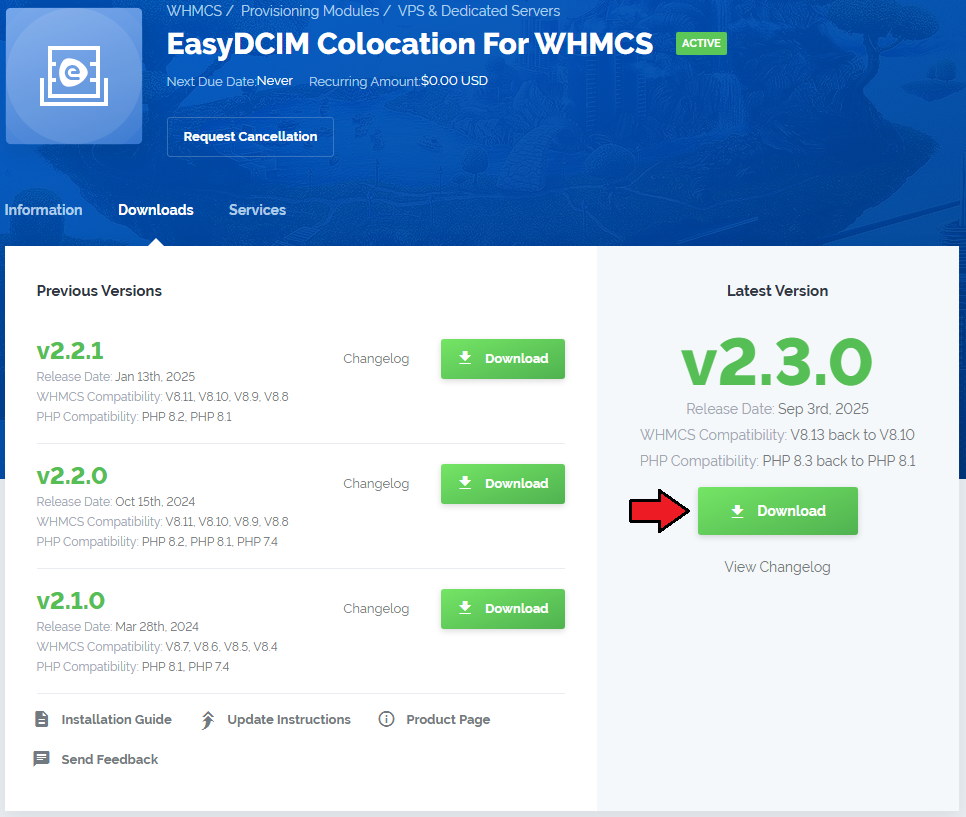
|
| 2. Extract the downloaded file into the main WHMCS directory. The content of the package should look like this. |

|
| If you are about to update your EasyDCIM Colocation module from v1 to v2? Remember to strictly follow the update instructions described at the bottom of this documentation! |
[edit] Configuration of Server
| 3. Now, we will show you how to configure a new product. Go to 'Setup' → 'Products/Services' → 'Servers' and press the 'Add New Server' button. |
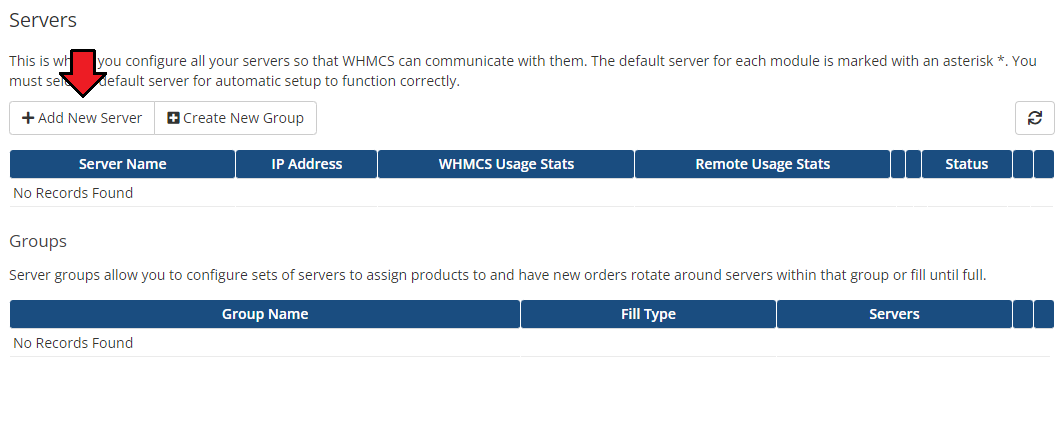
|
| 4. Next, choose 'EasyDCIMColocation' from the 'Type' dropdown menu. Fill in your server name, address, username and password (API Key). Then check the connection with the EasyDCIM V2 server and press 'Save Changes'. |
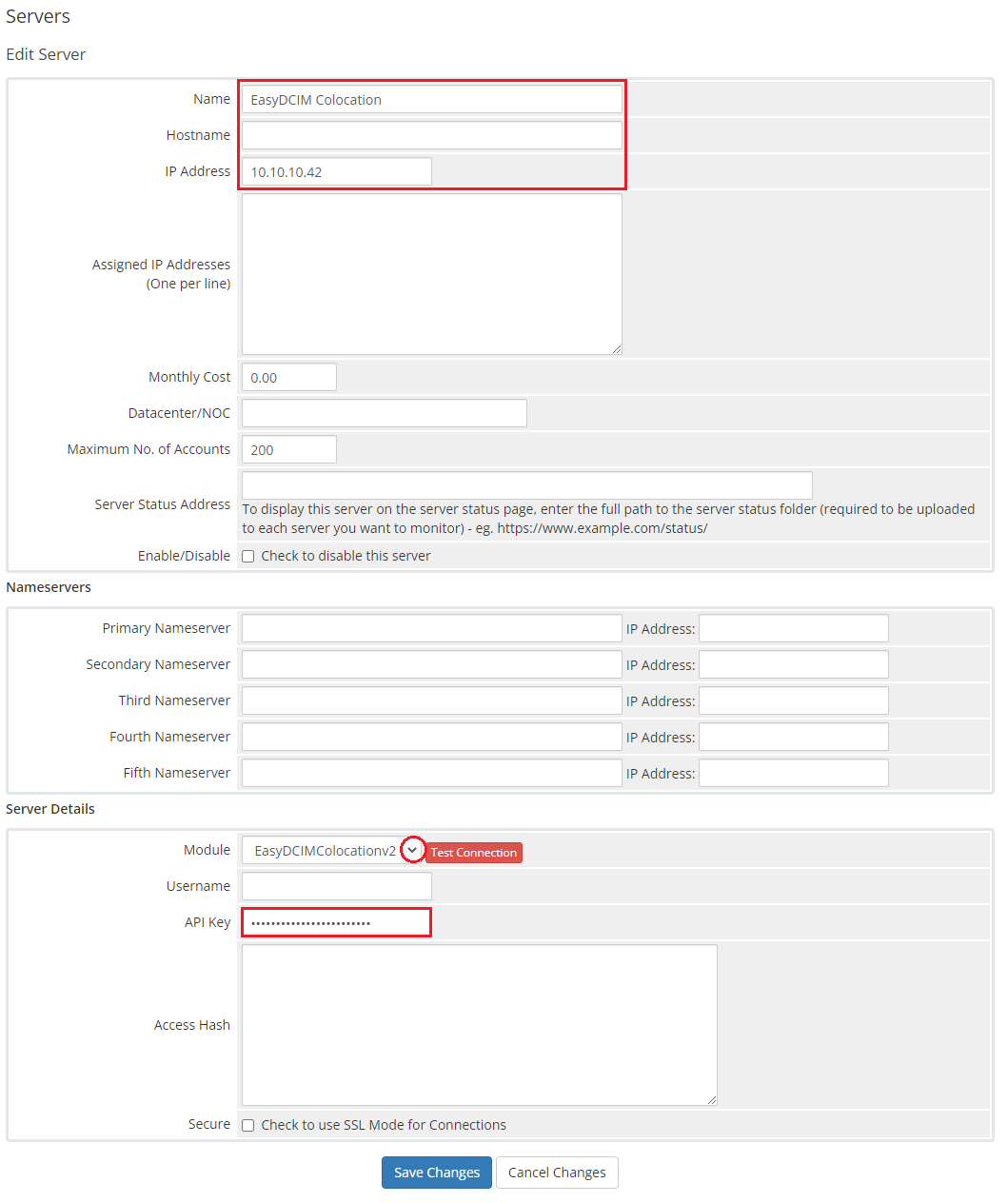
|
| 5. The next step is creating a server group. To do so, click on 'Create Server Group'. |
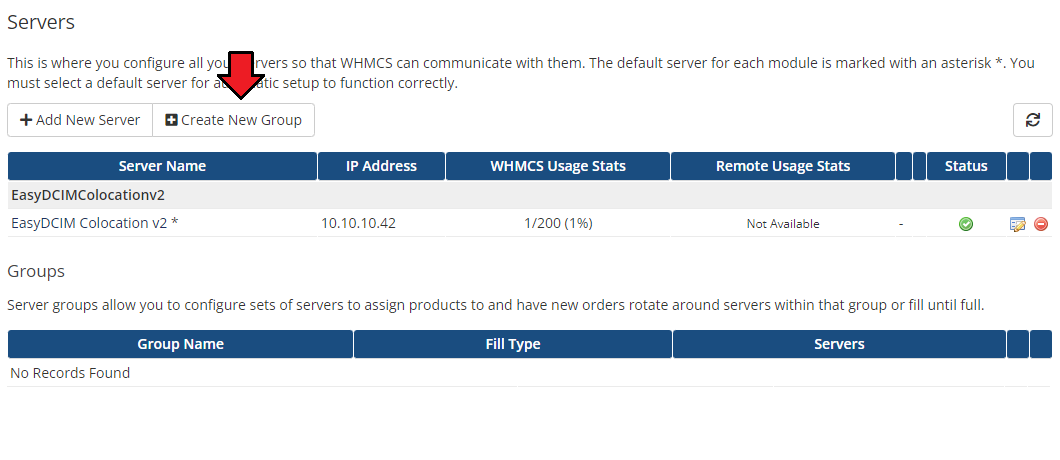
|
| 6. Enter the name, click on your previously created server, press 'Add' and 'Save Changes' afterwards. |
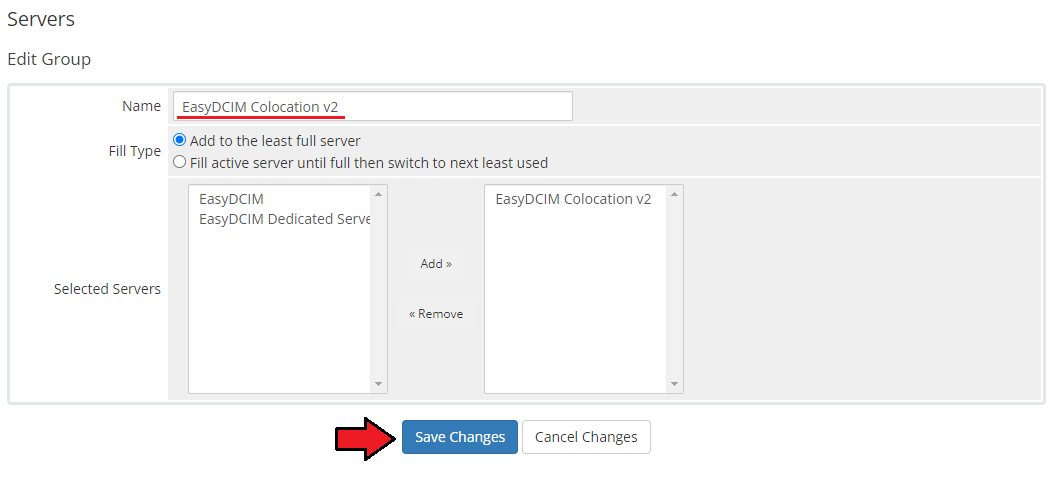
|
[edit] Configuration of Product
| 7. In order to create and configure a product, go to 'Setup' → 'Products/Services' → 'Products/Services'. Click on 'Create a New Group'. |

|
| 8. Enter the product group name and press 'Save Changes'. |
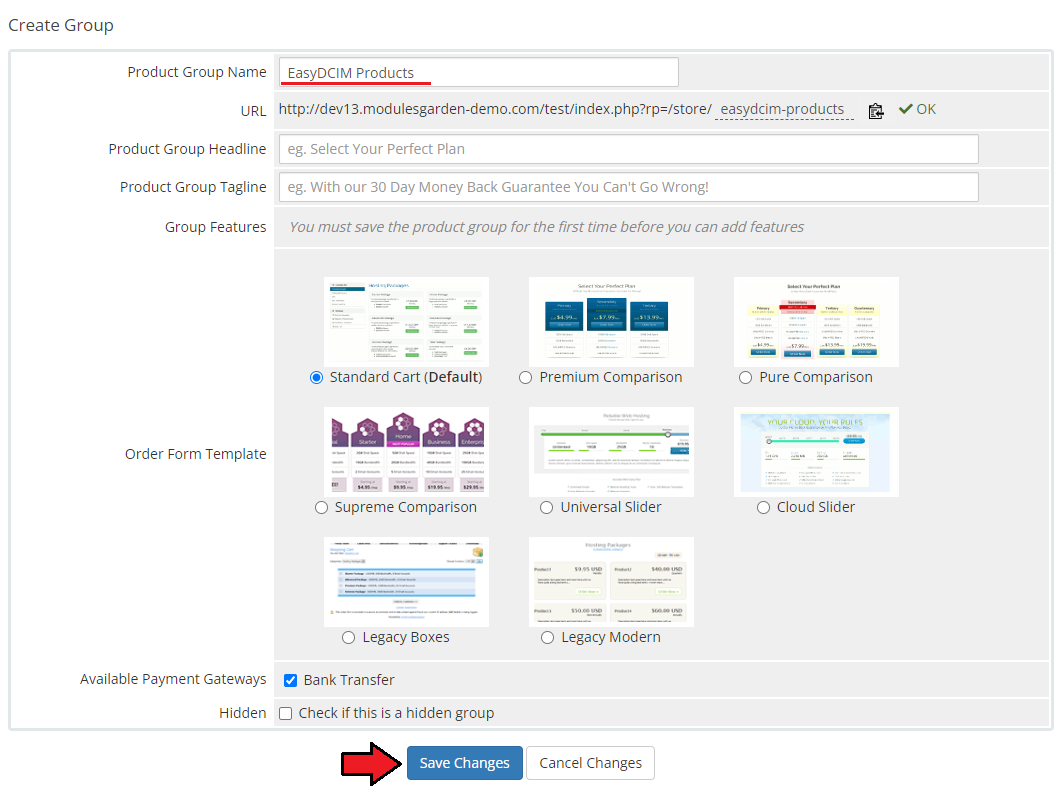
|
| 9. Once you have a product group, you can assign your product to it. To create a product, click on 'Create a New Product'. |

|
| 10. Next, choose your product group, enter your product name and then press 'Continue'. |
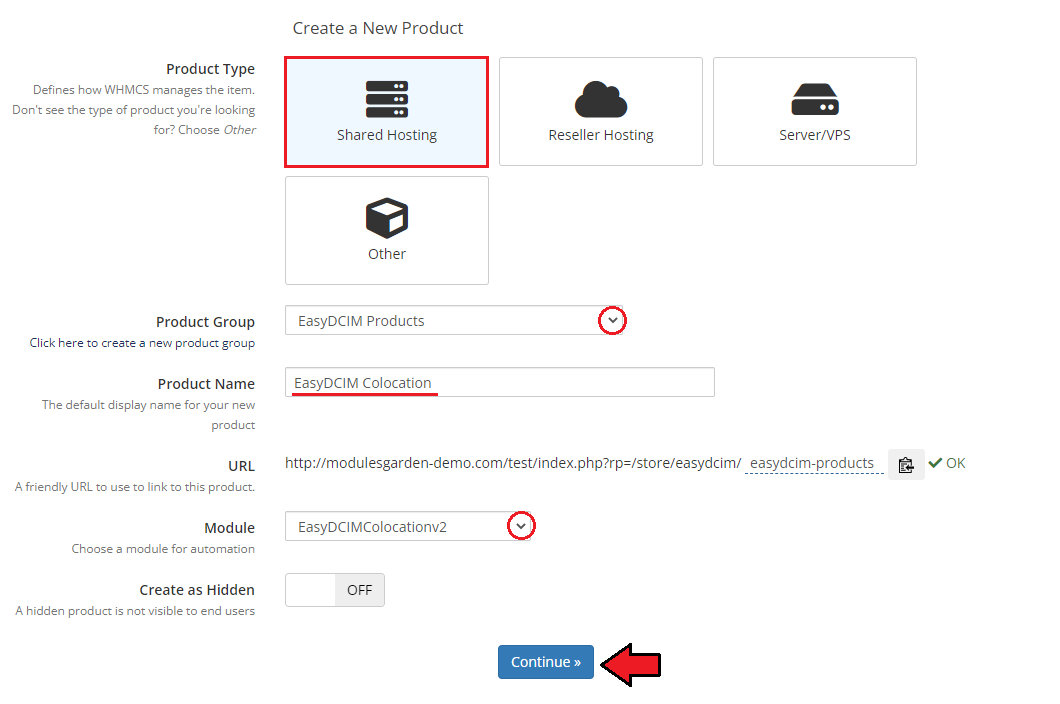
|
| 12. Now, move to the 'Module Settings' section. Keep in mind that the module configuration is only partly obligatory. The server will be assigned based on the provided configuration, and will therefore match only those options that have been specified. Default Options:
Note: generate configurable options if you want to overwrite the 'Location' and 'Model' in the 'Default Options' Automation Settings
Client Area Features- define the features and information that will be available for customers in the client area
Email Notifications
|
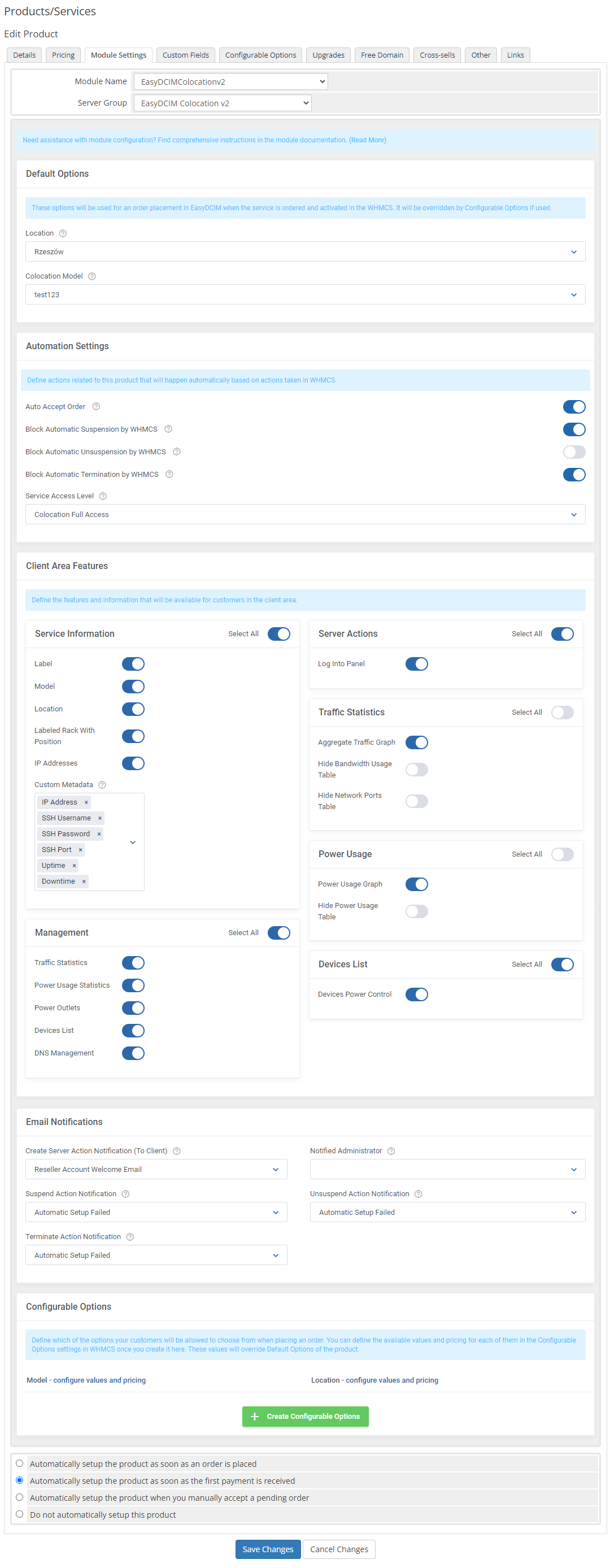
|
| 13. You can also generate the default configurable options to allow your customers place orders tailored exactly to their needs. To do that, go to 'Setup' → 'Products/Services' → 'Configurable Options'. |
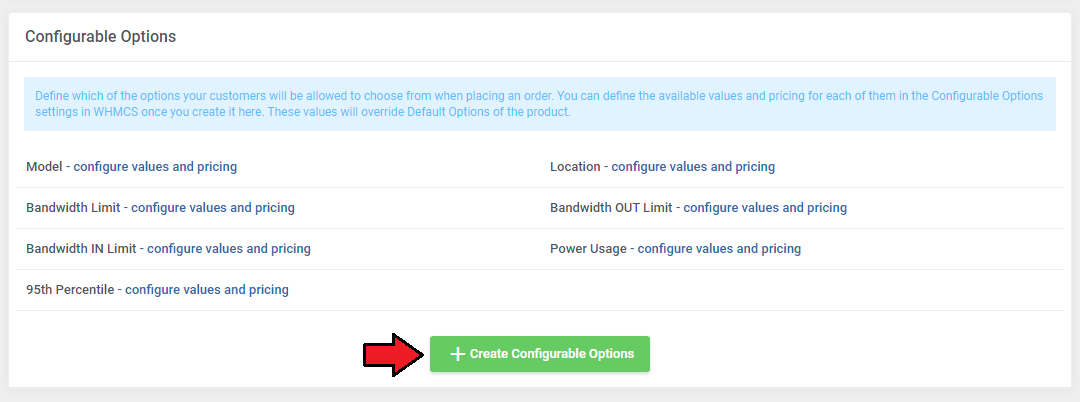
|
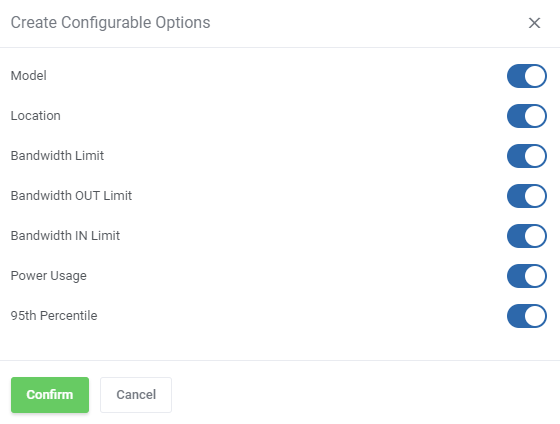
|
| 14. Additionally, you can set up a percentile billing for additional traffic. Note: This option is possible only if you do not have Advanced Billing Form WHMCS module installed. If you need a bit more advanced billing integration, please go here for more information.
E.g. If 'Soft Limit = 100' and 'Cost = 0.500' and the client exceeds the bandwidth by 10 Mbps, reaching to '110 Mbps' , they will be additionally charged with $5 USD (10 x 0.500). |
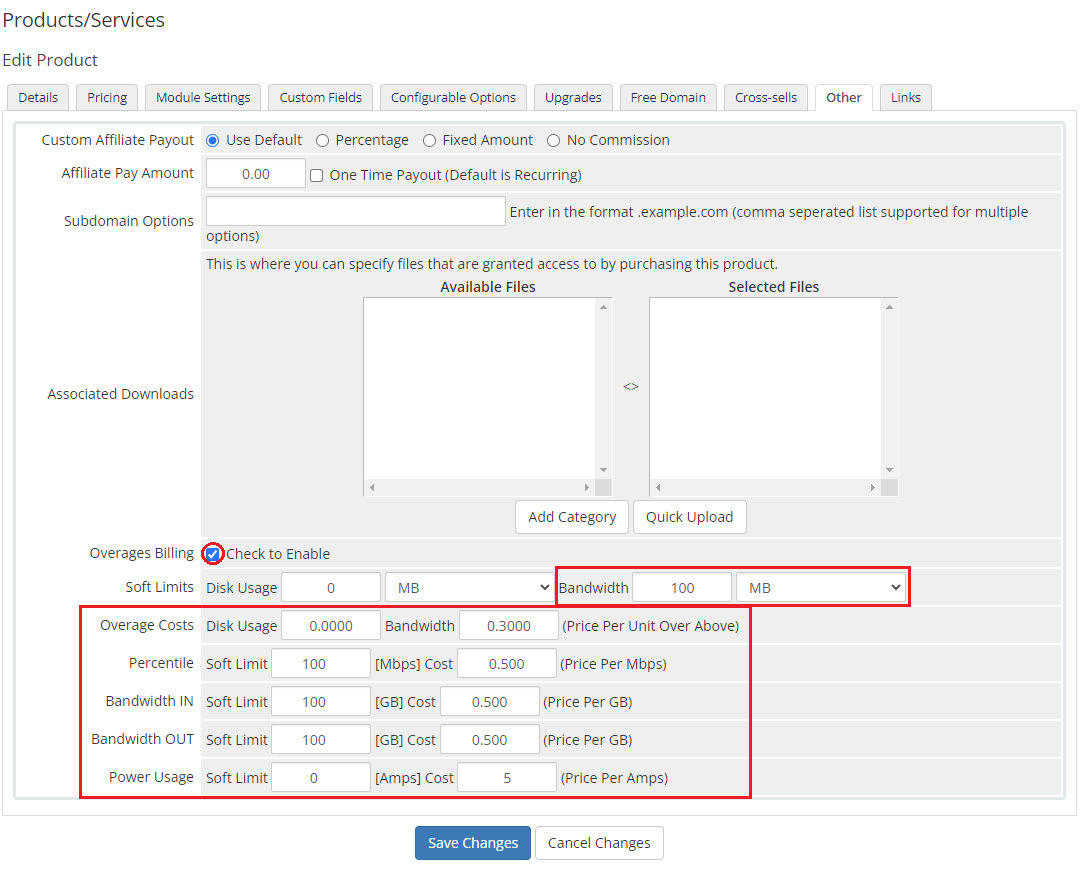
|
[edit] Custom Fields
| Once the configuration of the module settings has been completed, the following custom fields will be created automatically. Note: These fields will not be visible to your clients by default.
|
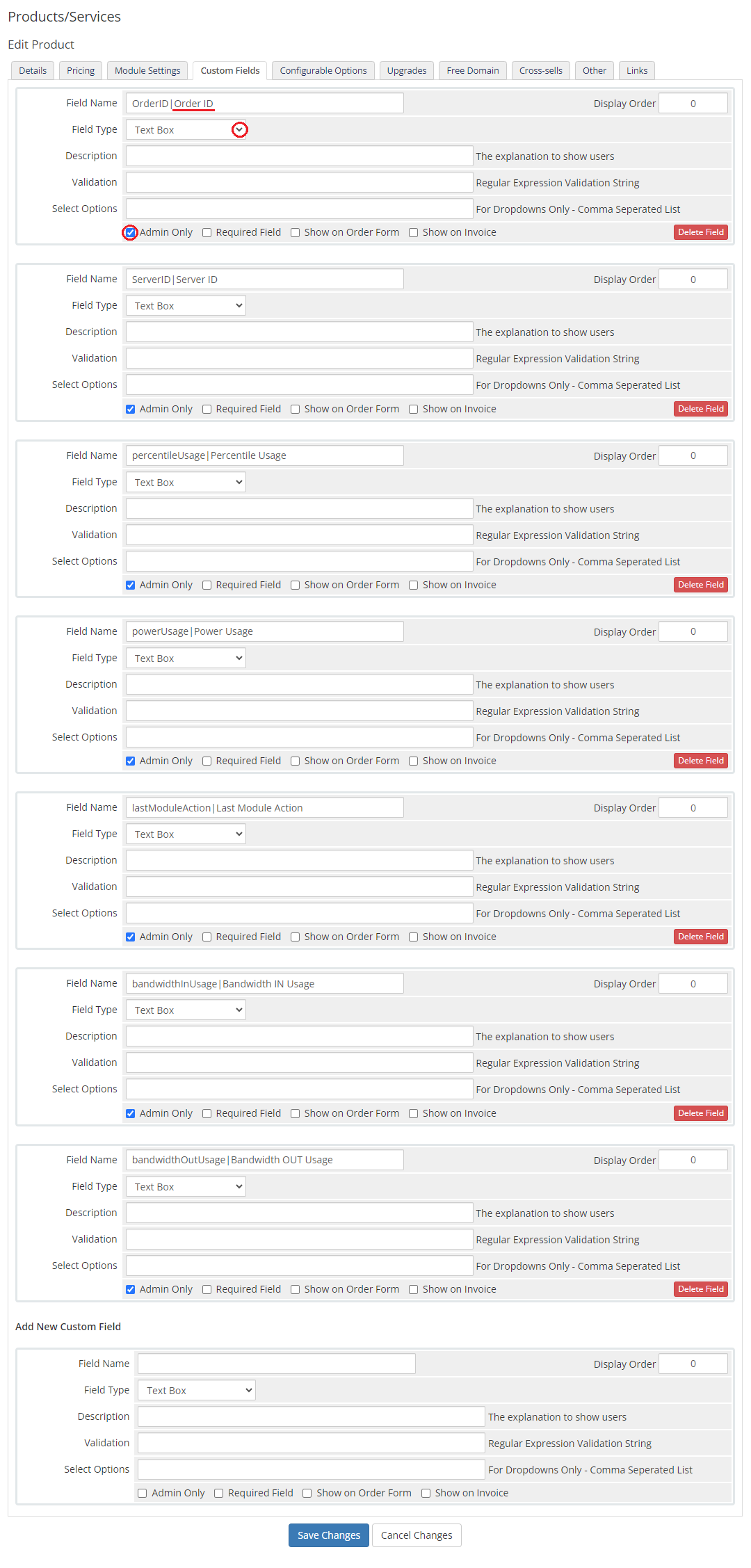
|
[edit] Management
| In this section we will show you all functionalities of EasyDCIM Colocation For WHMCS. Our module allows you to offer and manage EasyDCIM colocation service right in your WHMCS system. |
[edit] Admin Area
|
As soon as you set up a server for a client, you can perform various actions and view server details from the WHMCS admin area.
|
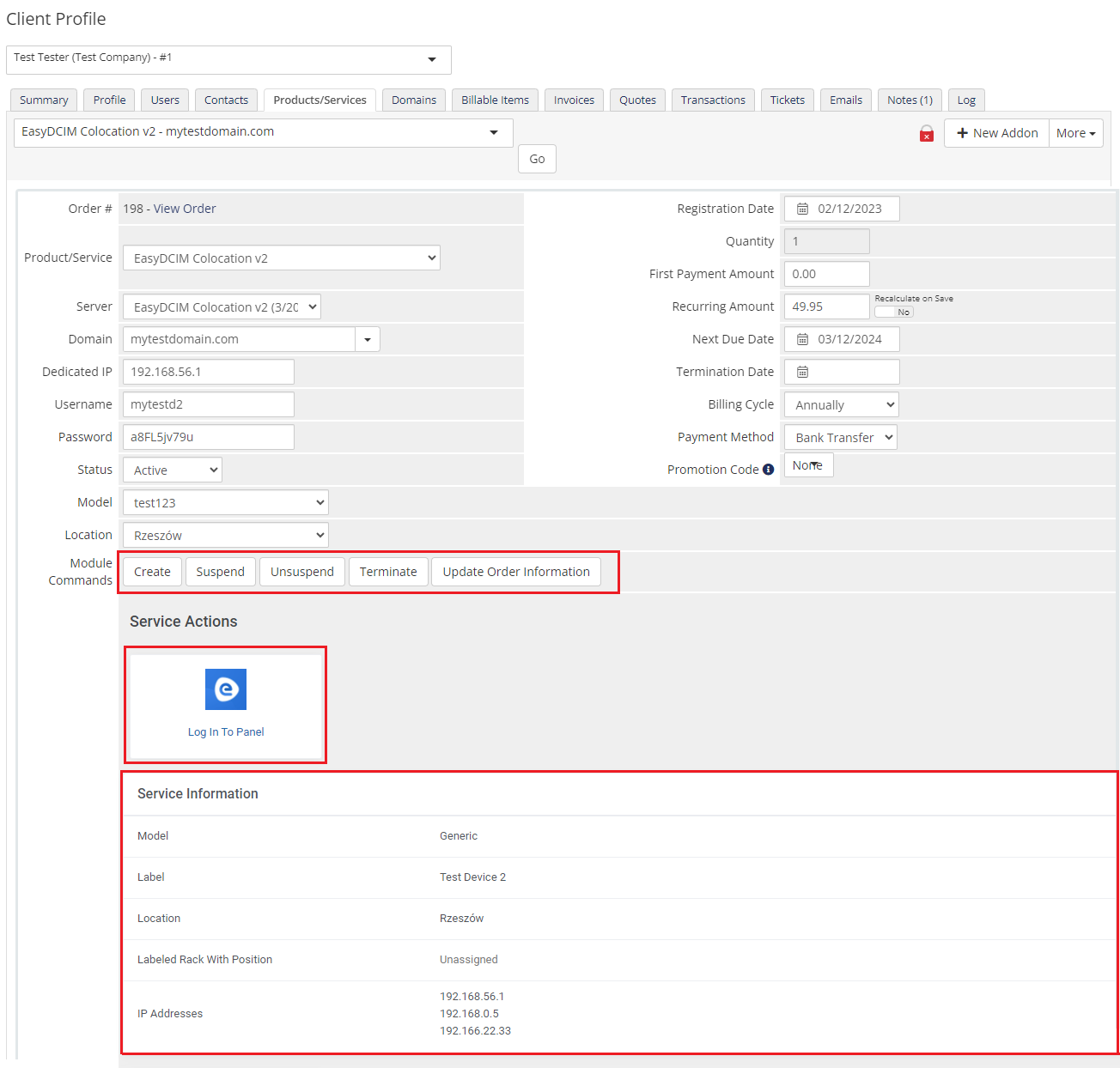
|
| Below these functions you can also view traffic and power usage statistics and even specify the time intervals. |
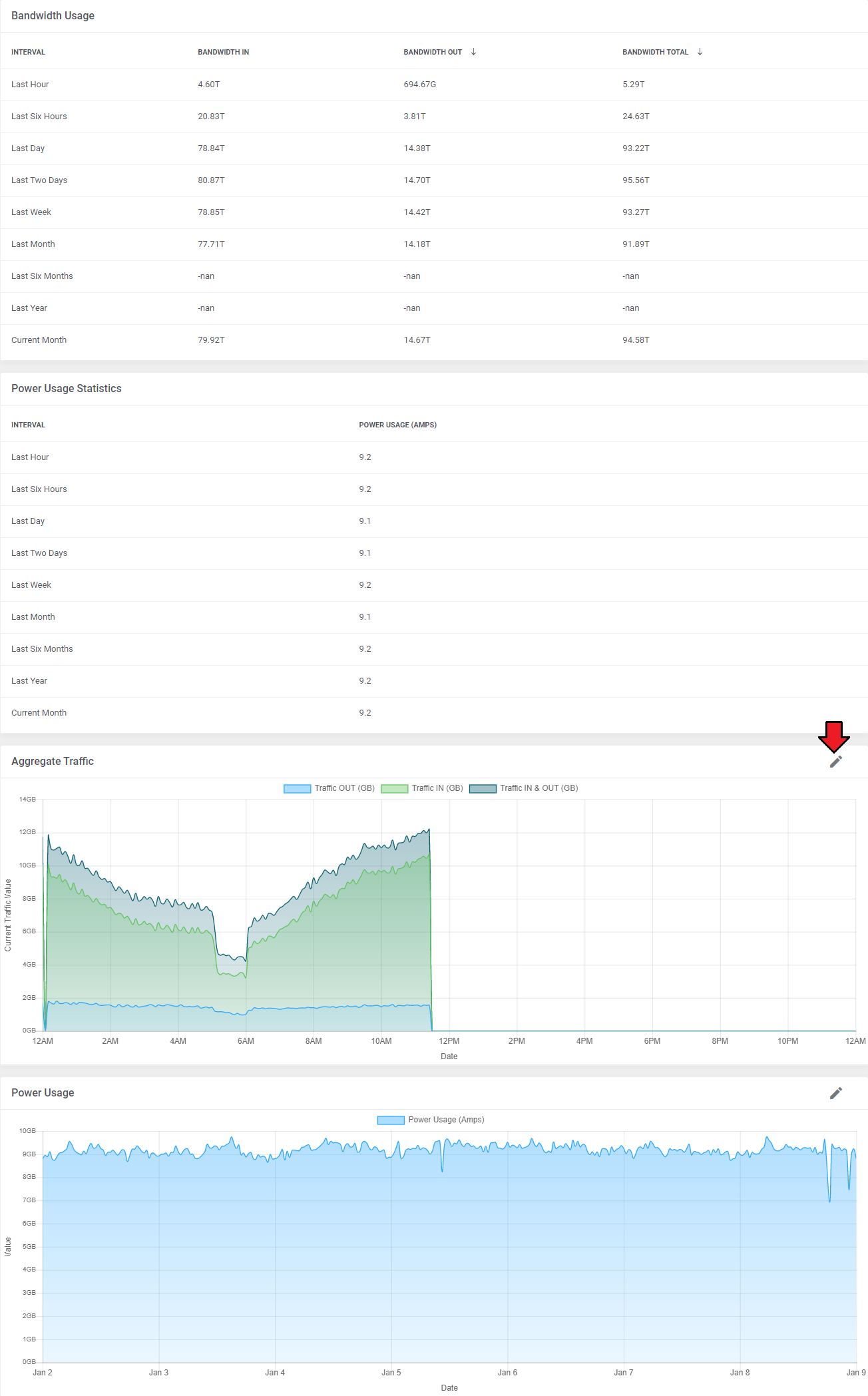
|
| Lastly, you can also see the custom fields with currently assigned 'Order ID' and 'Server ID' from the EasyDCIM panel. An empty 'Server ID' field means that it has not been automatically assigned by the cron yet (e. g. it may not be activated in the EasyDCIM panel yet). |

|
[edit] Client Area
| In the main view of the client area your customers can check basic details of a colocation service as well as log in to their EasyDCIM control panel with a single click. |
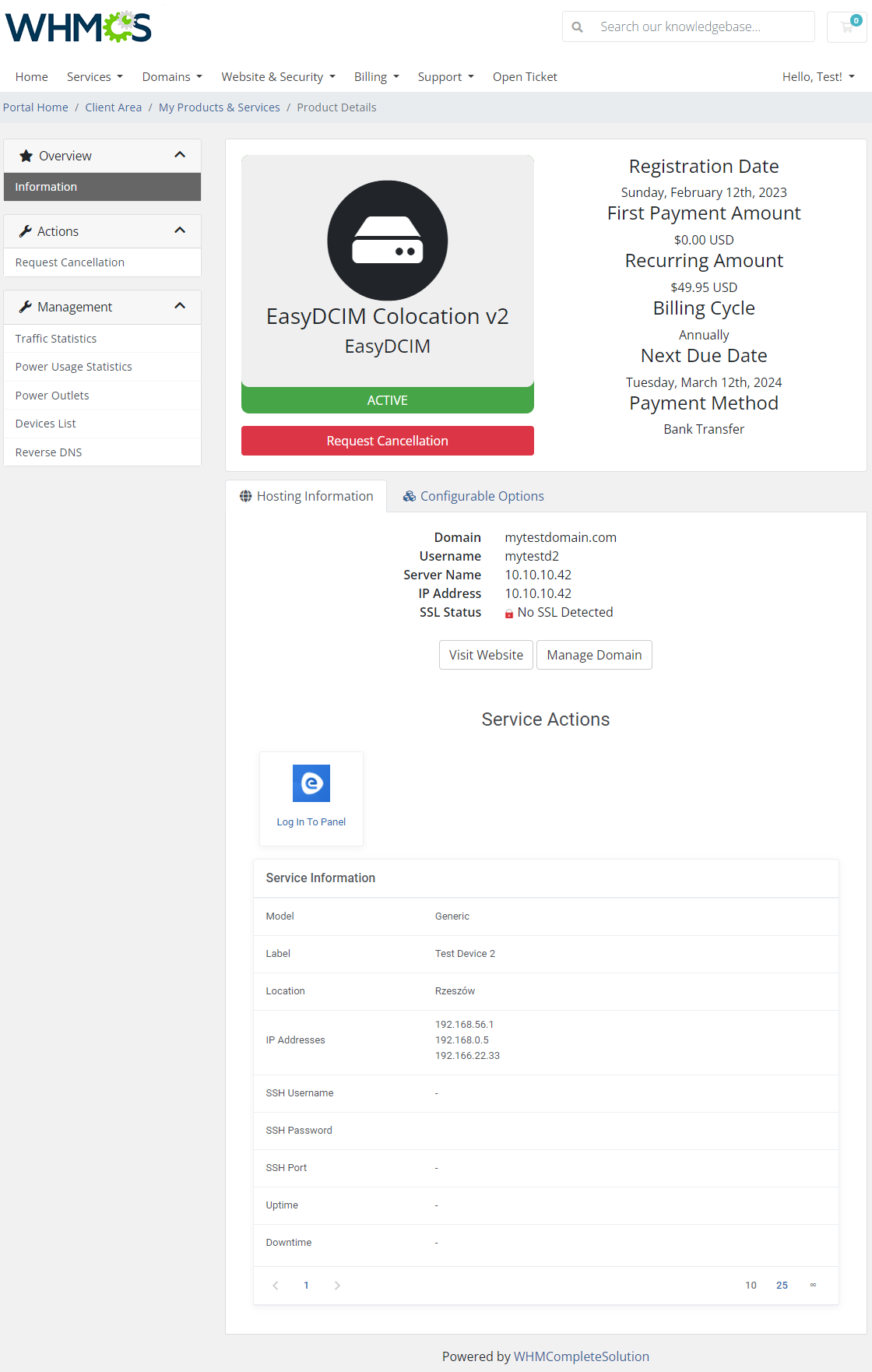
|
| They can view the graphs with traffic statistics and even define time intervals. Note: Available graphs and time intervals depend on the product registration date. |
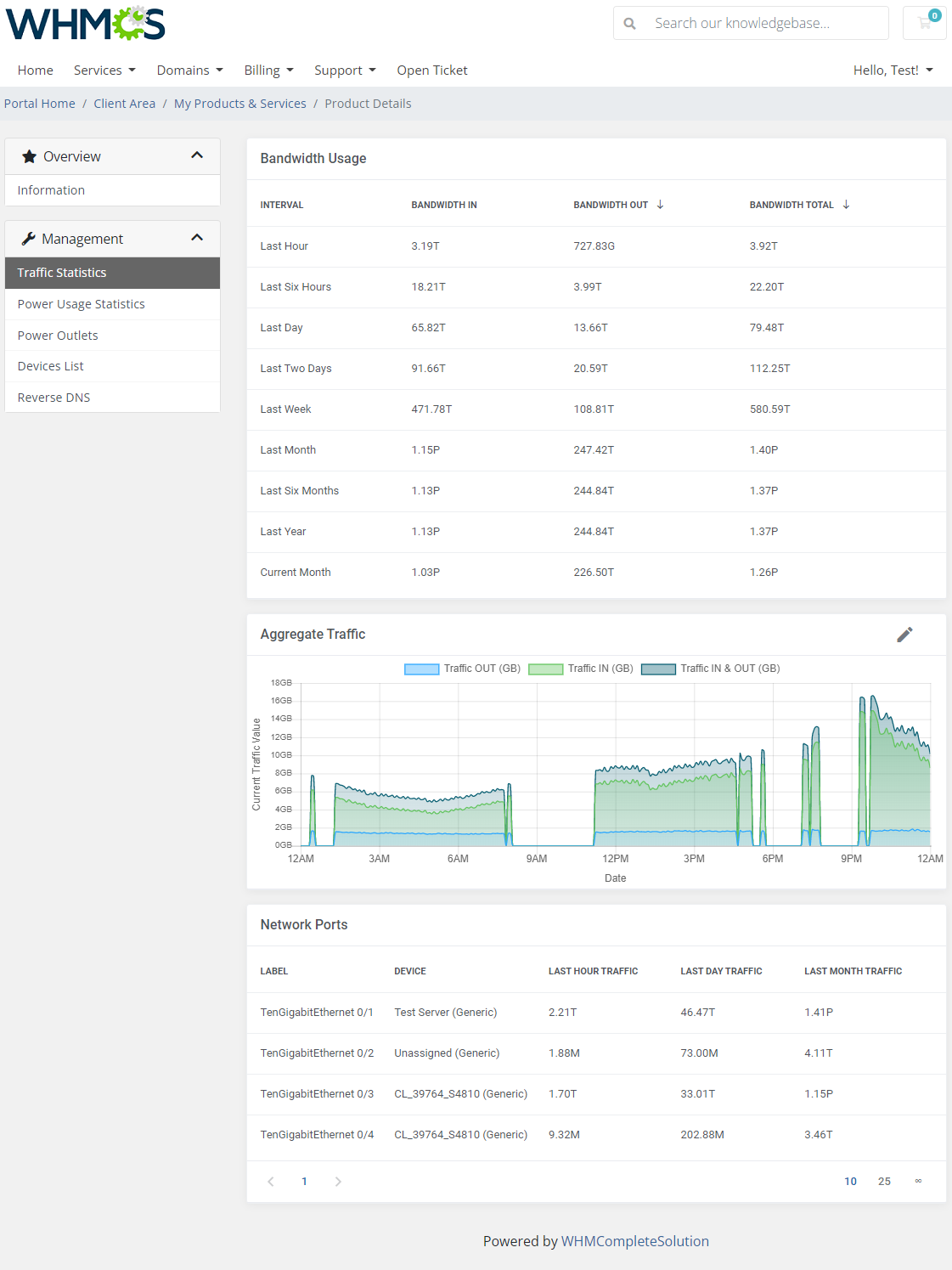
|
| The same goes for power usage statistics. |
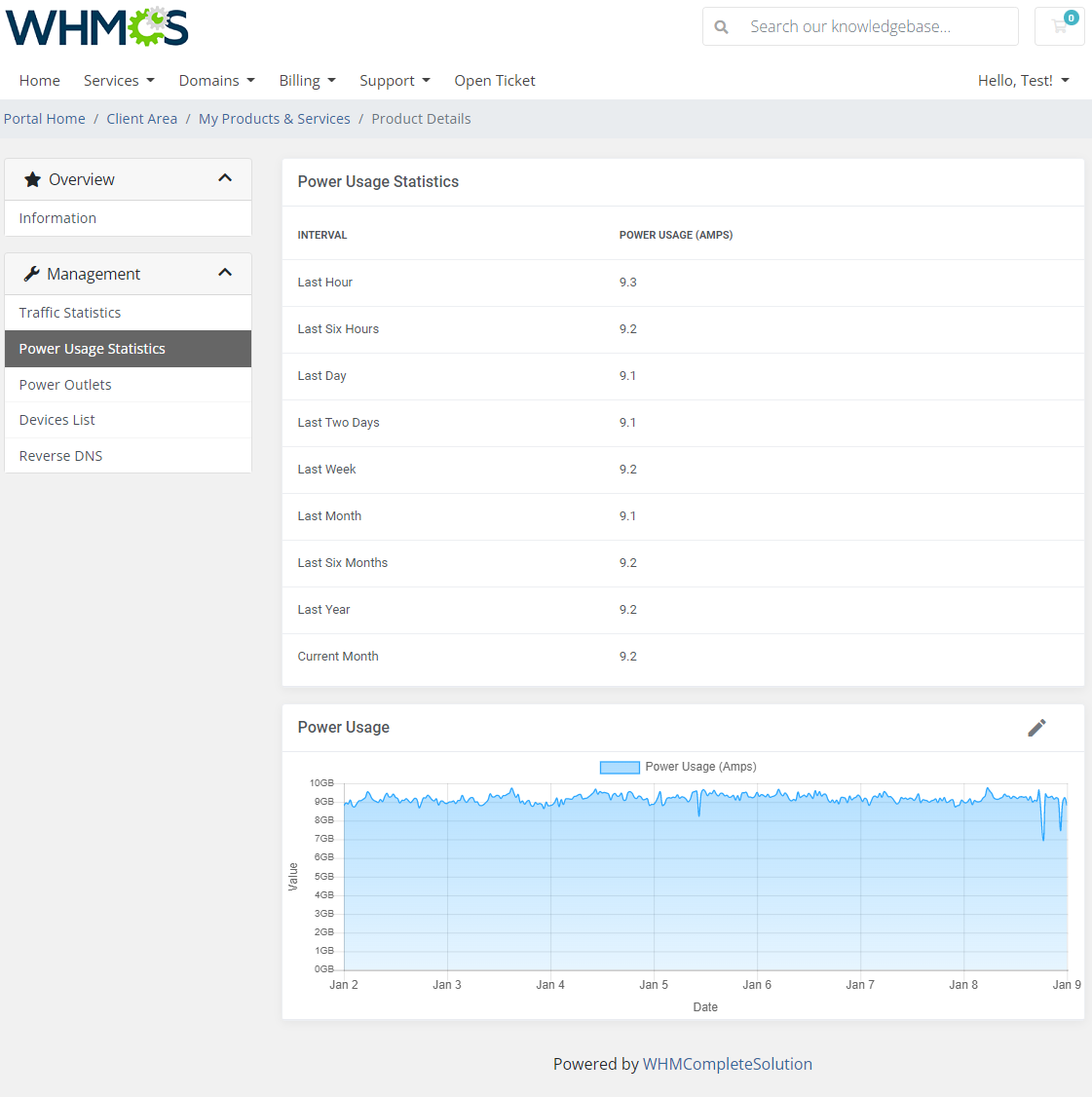
|
| Additionally, your clients can see the current state of all power outlets with the possibility to turn them on, off or restart. |
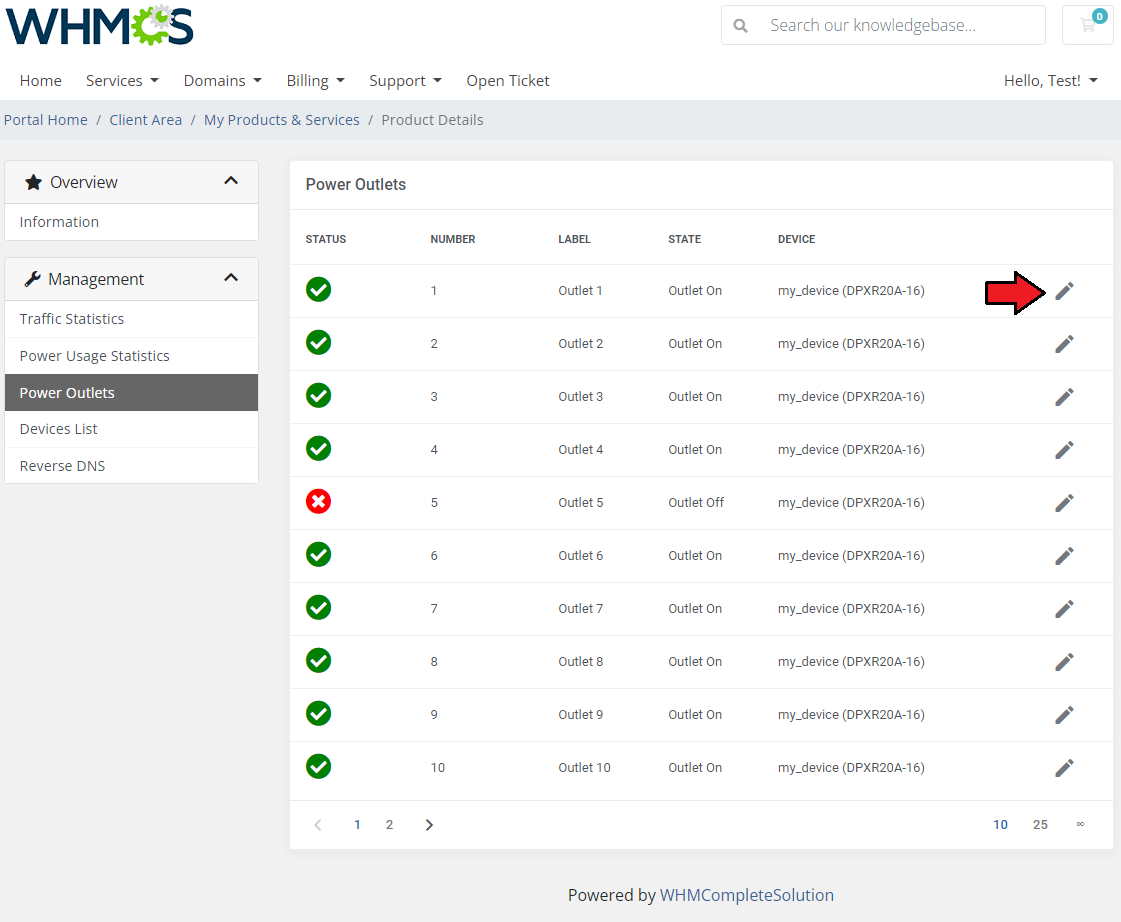
|
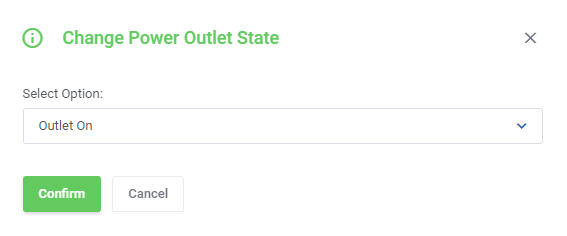
|
| Information regarding devices can be found on the 'Devices List,' this includes their name, IP and location. If the 'Devices Power Control' option is enabled, the users will find remote control buttons next to each device, allowing them to restart, shut down, and power on the device. |
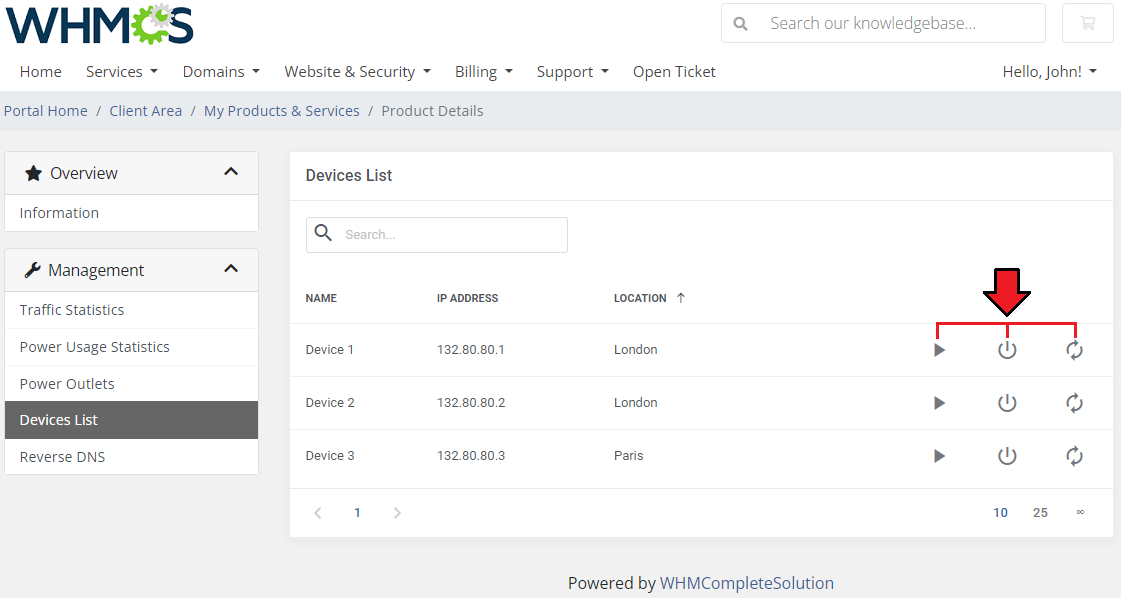
|
[edit] Advanced Billing Integration
| EasyDCIM Colocation For WHMCS supports integration with the Advanced Billing For WHMCS module. This allows you to charge your customers for total bandwidth (In, Out and Total), power usage and 95th percentile (In, Out and Total) billing for additional traffic. Note: We suggest to run the cron only once per hour (with the interval of 3600 seconds). |
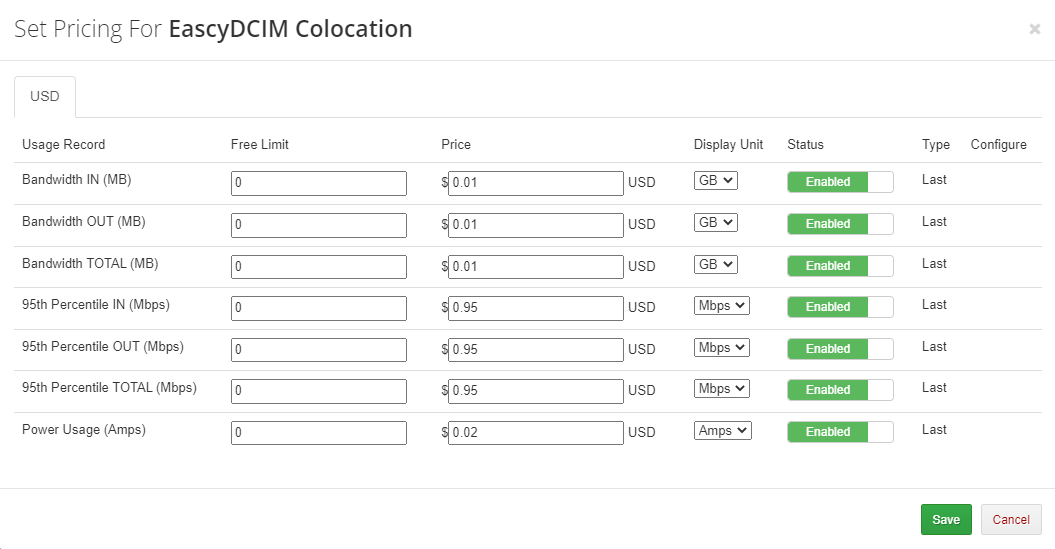
|
| Once the relevant options are enabled, your clients will also be able to view billing for the current usage in your client area. |
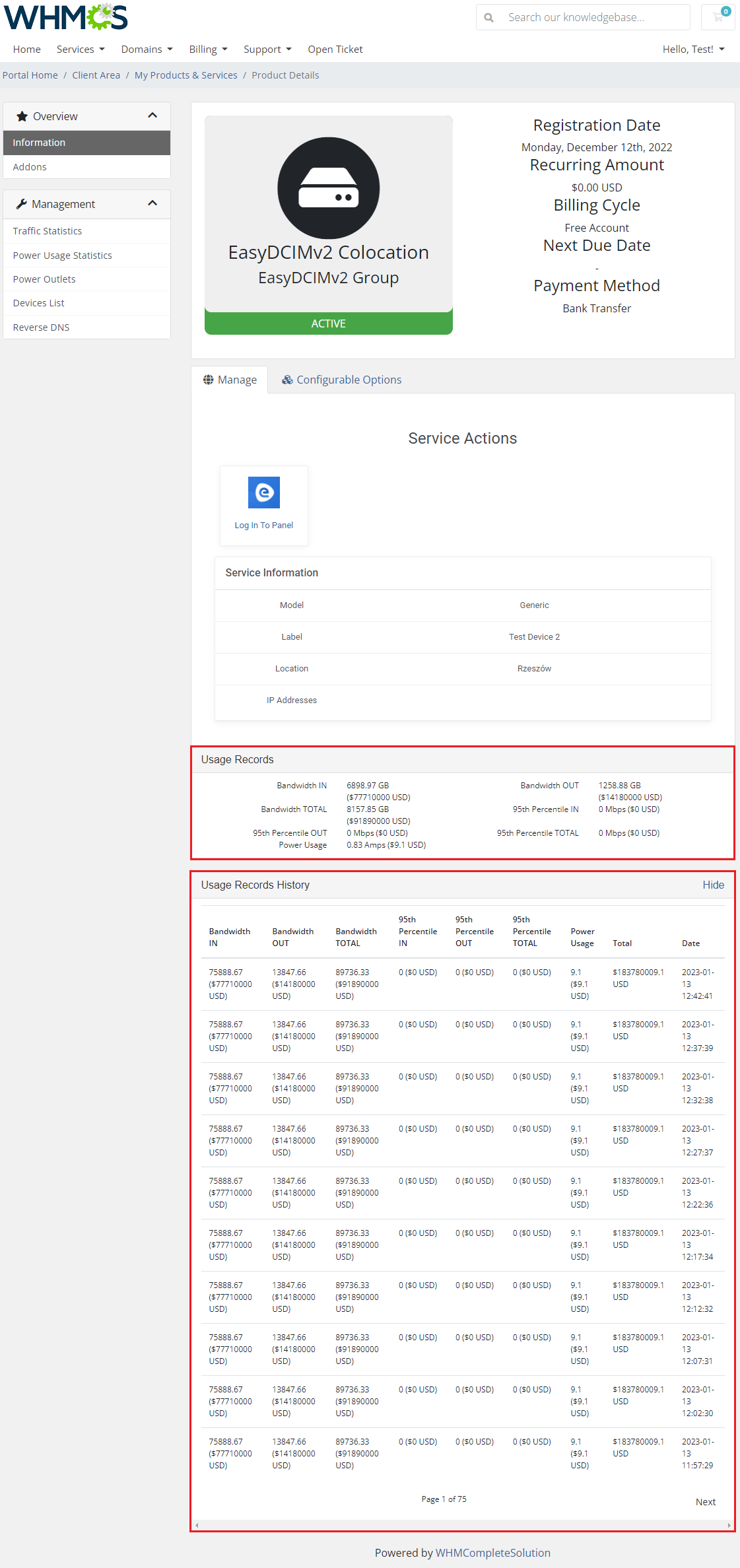
|
[edit] Tips
| 1. Note that placing two identical orders may result in assigning servers with slightly different parameters.
It is a natural result of how server matching in EasyDCIM works. In brief, it matches a server basing on the resources and models precised in the order, without considering other resources. |
[edit] How To Use Language Overrides
| Incorporating language customizations - the module readily accommodates language overrides, allowing you to tailor the language files to your preferences. The language file english.php remains unencoded and can be modified to suit your needs. However, it's recommended to avoid altering the core file itself, and instead, leverage the capability of using overrides. |
Here's how to apply language overrides:
~/langs/overrides/english.php.
For example: Original yourWHMCS/modules/servers/moduleName/langs/english.php: $_LANG['Search'] = 'Search'; Override yourWHMCS/modules/servers/moduleName/langs/overrides/english.php: $_LANG['Search'] = 'Look for'; |
| By following these steps, you can seamlessly implement language customizations without altering the core language file, ensuring your changes will not be lost after every module update. Remember that some of the modules have more than one language file, located under /addons and /servers paths. You may create the override files for both of them. |
[edit] Update Instructions
| If you are updating your EasyDCIM Colocation For WHMCS module and wish to migrate your data to the new V2 module version, it is advised to familiarize yourself with the below instructions firstly. Please follow the instructions step by step to avoid any unexpected errors. |
| Start with making a backup copy of your WHMCS files and database. This step is crucial as it will let you avoid losing any data in case of unexpected update failure or other issues. |
| 1. Download the latest version of the module from our client area. |
| 2. Upload and extract the new module files into your WHMCS root directory. |
| 3. Move to the System Settings → Servers, create a new server and a new server group dedicated to the EasyDCIMcolocationv2 module. |
| 4. Move to the System Settings → Products/Services, find and open the product you are going to update. |
| 5. Open the Module Settings section of the product of you interest, find and open the product you are going to update. |
| 6. Change the 'Module Name' from "EasyDCIMColocation" to "EasyDCIMColocationv2". Change the 'Server Group' to the created in the step 4th one. |
| 7. Configure the module settings from scratch and save the changes. |
8. Open the Custom Fields section, correct the existing custom fields names as shown below:
|
| 9. Generate any configurable options if need any. |
10.* Regarding billing methods update:
|
[edit] Common Problems
| 1. When you encounter problems with connection, check whether your SELinux or firewall does not block ports. |